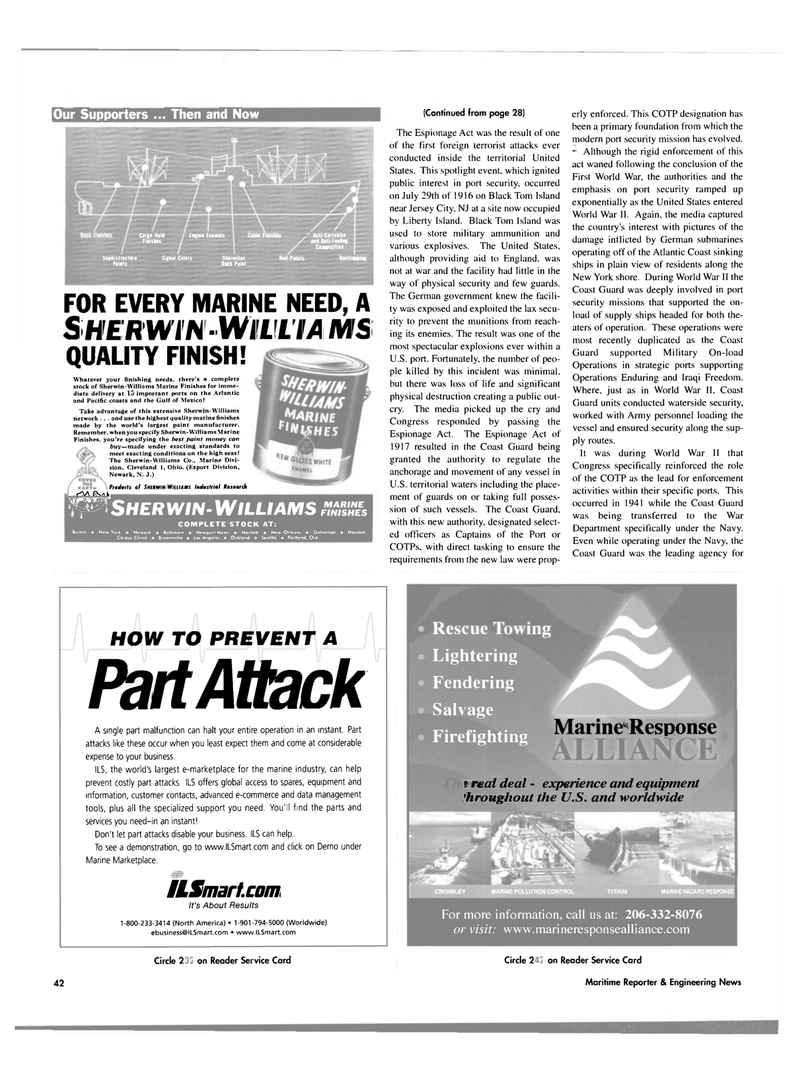
Page 40: of Maritime Reporter Magazine (August 2004)
65th Anniversary Edition
Read this page in Pdf, Flash or Html5 edition of August 2004 Maritime Reporter Magazine
Our Supporters ... Then and Now
Cargo Hold
Finishes (•fine Enamels ' Anti Corrosiu and Anti Fouling
Composition
Superstructure
Paints
Signal Colors Sherwiliac
Dick Paint
FOR EVERY MARINE NEED, A
SHERWIN-WILLIAMS
QUALITY FINISH!
Whatever your finishing needs, there's a complete stock of Sherwin-Williams Marine Finishes for imme- diate delivery at 15 important ports on the Atlantic and Pacific coasts and the Gulf of Mexico!
Take advantage of this extensive Sherwin-Williams network. . . and use the highest quality marine finishes made by the world's largest paint manufacturer.
Remember, when you specify Sherwin-Williams Marine
Finishes, you're specifying the best paint money can buy—made under exacting standards to meet exacting conditions on the high seas!
The Sherwin-Williams Co., Marine Divi- sion, Cleveland 1, Ohio. (Export Division,
Newark, N. J.)
Products of SHERWIN-WILLIAMS Industrial Research rtAPsnb f^SHERWIN-WlLLIAMS Zigffls
COMPLETE STOCK AT:
Boston • New York • Newark • Baltimore • Newport News • Norfolk • New Orleans • Golveston • Houston
Corpus Christi • Brownsville • lot Angeles • Oakland • Seottle • Portlond, Ore. (Continued from page 28)
The Espionage Act was the result of one of the first foreign terrorist attacks ever conducted inside the territorial United
States. This spotlight event, which ignited public interest in port security, occurred on July 29th of 1916 on Black Tom Island near Jersey City. NJ at a site now occupied by Liberty Island. Black Tom Island was used to store military ammunition and various explosives. The United States, although providing aid to England, was not at war and the facility had little in the way of physical security and few guards.
The German government knew the facili- ty was exposed and exploited the lax secu- rity to prevent the munitions from reach- ing its enemies. The result was one of the most spectacular explosions ever within a
U.S. port. Fortunately, the number of peo- ple killed by this incident was minimal, but there was loss of life and significant physical destruction creating a public out- cry. The media picked up the cry and
Congress responded by passing the
Espionage Act. The Espionage Act of 1917 resulted in the Coast Guard being granted the authority to regulate the anchorage and movement of any vessel in
U.S. territorial waters including the place- ment of guards on or taking full posses- sion of such vessels. The Coast Guard, with this new authority, designated select- ed officers as Captains of the Port or
COTPs, with direct tasking to ensure the requirements from the new law were prop- erly enforced. This COTP designation has been a primary foundation from which the modern port security mission has evolved. - Although the rigid enforcement of this act waned following the conclusion of the
First World War, the authorities and the emphasis on port security ramped up exponentially as the United States entered
World War II. Again, the media captured the country's interest with pictures of the damage inflicted by German submarines operating off of the Atlantic Coast sinking ships in plain view of residents along the
New York shore. During World War II the
Coast Guard was deeply involved in port security missions that supported the on- load of supply ships headed for both the- aters of operation. These operations were most recently duplicated as the Coast
Guard supported Military On-load
Operations in strategic ports supporting
Operations Enduring and Iraqi Freedom.
Where, just as in World War II, Coast
Guard units conducted waterside security, worked with Army personnel loading the vessel and ensured security along the sup- ply routes.
It was during World War II that
Congress specifically reinforced the role of the COTP as the lead for enforcement activities within their specific ports. This occurred in 1941 while the Coast Guard was being transferred to the War
Department specifically under the Navy.
Even while operating under the Navy, the
Coast Guard was the leading agency for
HOW TO PREVENT A Part Attack
A single part malfunction can halt your entire operation in an instant. Part attacks like these occur when you least expect them and come at considerable expense to your business.
ILS, the world's largest e-marketplace for the marine industry, can help prevent costly part attacks. ILS offers global access to spares, equipment and information, customer contacts, advanced e-commerce and data management tools, plus all the specialized support you need. You'll find the parts and services you need-in an instant!
Don't let part attacks disable your business. ILS can help.
To see a demonstration, go to www.ILSmart.com and click on Demo under
Marine Marketplace. llSmart.com
It's About Results 1-800-233-3414 (North America) • 1-901-794-5000 (Worldwide) [email protected] • www.ILSmart.com
Circle 205 on Reader Service Card 42
Circle 200 on Reader Service Card
Maritime Reporter & Engineering News
Rescue Towing
Lightering
Fendering
Salvage
Firefighting
MARINE HAZARD RESPONSE MARINE POLLUTION CONTROL
For more information, call us at: 206-332-8076 or visit: www.marineresponsealliance.com
Marine Response ? real ilea! - experience and equipment throughout the U.S. and worldwide

 39
39

 41
41
